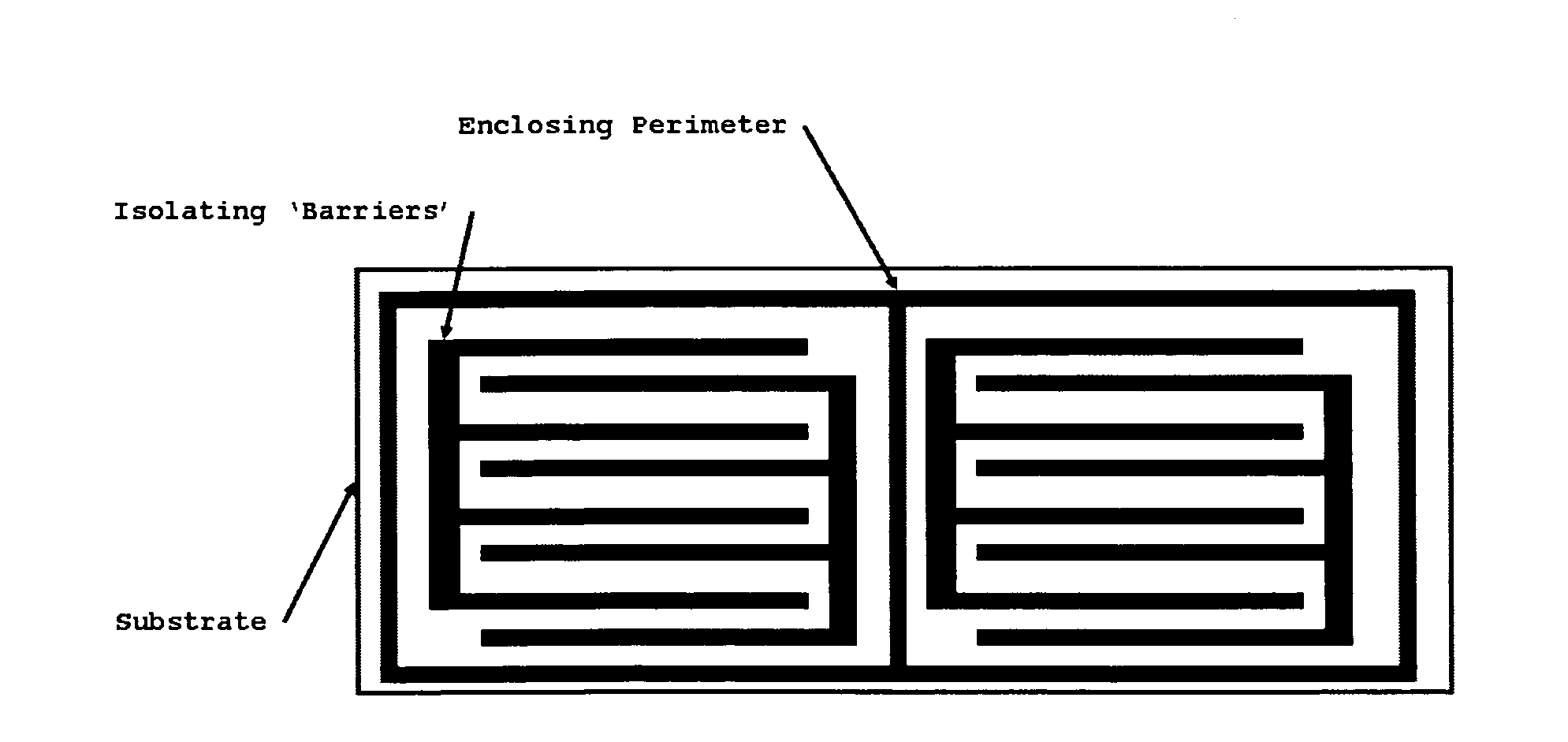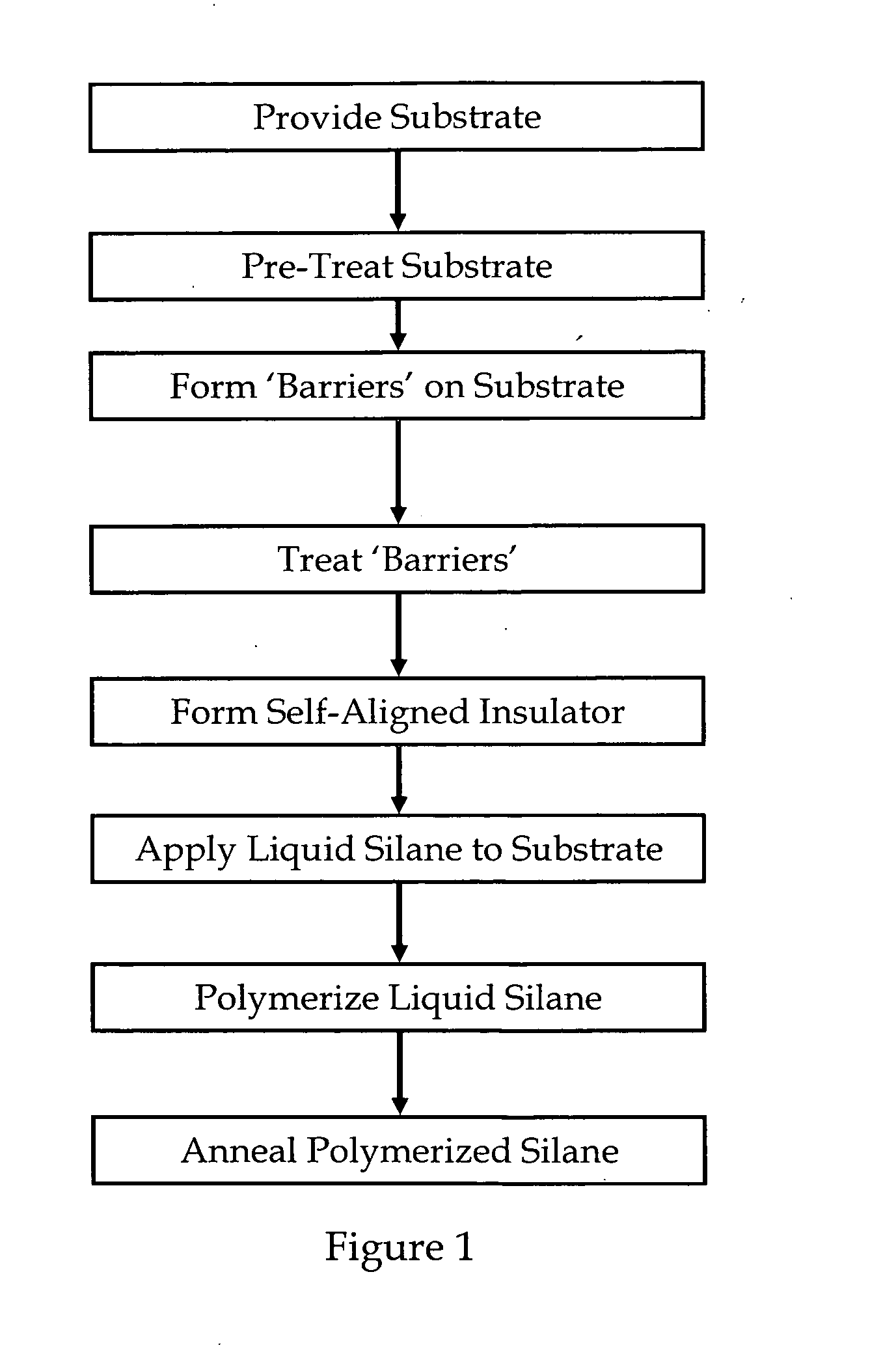Methods for increasing film thickness during the deposition of silicon films using liquid silane materials
a technology of liquid silane and film thickness, which is applied in the field of increasing film thickness during the deposition of silicon films using liquid silane materials, can solve the problems of prohibitively expensive use of conventional cvd techniques to deposit films 1 m, impractical processing of a single substrate at a time, etc., and achieves low cost, simple pre- and post-processing of applied films, and minimizing contamination of resulting films
- Summary
- Abstract
- Description
- Claims
- Application Information
AI Technical Summary
Benefits of technology
Problems solved by technology
Method used
Image
Examples
example 1
[0101]FIG. 6 shows a simplified flow diagram of an embodiment of a process for forming a silicon layer in accordance with the present invention. Each of the blocks represents a chamber into which the substrate is transferred using a form of conveyor belt from the preceding chamber. Each chamber is interconnected with the adjacent chamber through an interlock (not needed to be hermetic seal) and kept under positive N2 pressure in order to maintain O2 levels at sub 10 ppm in the atmosphere. The O2 environment is needed to protect the films from contamination and adverse changes in the film properties.
[0102]In this particular embodiment, the substrate comprises glass having a thickness of 2-3 mm. Equipment used in the manufacture of flat panel display devices could be applicable to form the silicon layers of the present invention. For example, the tools used in the fabrication of flat panel displays for generation 4 (Glass—730 mm×920 mm) could be used.
[0103]It is understood that the su...
example 2
[0136]FIG. 7 provides an illustration of another example of a process flow illustrating an embodiment of the present invention which implements formation of a silicon film in a manner that optimizes the flow in a production manufacturing environment. Two advantages are offered by this approach. First, it does not require the ink printing of the barrier material. Secondly, it uses electroplating to obtain self aligned barriers. In addition, the Poly Methyl Methacrylate (PMMA) can be replaced by a positively photoresist that might offer the additional advantage of increasing the process time by simply exposing the barrier features using a scanned laser beam. It should be possible to use this approach to create high aspect ratio (i.e. vertical) profile of the barriers.
[0137]1. Prime / Dry
[0138]Again, the substrate is loaded into the chamber. A priming process is applied which prepares the top surface so the PMMA will adhere. Examples of such a priming process include but are not limited ...
example 3
[0169]FIGS. 9A-9C show another method for creating a barrier which can retain the liquid silane fluid during the coating process.
[0170]FIG. 9A shows a top view, and FIG. 9AA shows a side view, depicting how a removable retaining ring can be press fitted against the perimeter of the substrate. If, for example, the substrate is a glass sheet 1.5×1.0 square meters the retaining ring would typically match the outer perimeter in dimensions but have a width approximating 1 centimeter.
[0171]After the retaining ring is pressed against the substrate the liquid silane is dispensed into the ring as shown in FIG. 9B. The liquid fills the cavity formed by the walls of the retaining ring.
[0172]Once the liquid has been dispensed, UV lamps scan the surface of the coated substrate to induce polymerization of the liquid silane into polysilane solid, as shown in the top and side views of FIGS. 9C-9CA. Once the liquid silane has been converted into the solid polysilane, the retaining ring can be remove...
PUM
 Login to View More
Login to View More Abstract
Description
Claims
Application Information
 Login to View More
Login to View More - R&D
- Intellectual Property
- Life Sciences
- Materials
- Tech Scout
- Unparalleled Data Quality
- Higher Quality Content
- 60% Fewer Hallucinations
Browse by: Latest US Patents, China's latest patents, Technical Efficacy Thesaurus, Application Domain, Technology Topic, Popular Technical Reports.
© 2025 PatSnap. All rights reserved.Legal|Privacy policy|Modern Slavery Act Transparency Statement|Sitemap|About US| Contact US: help@patsnap.com



